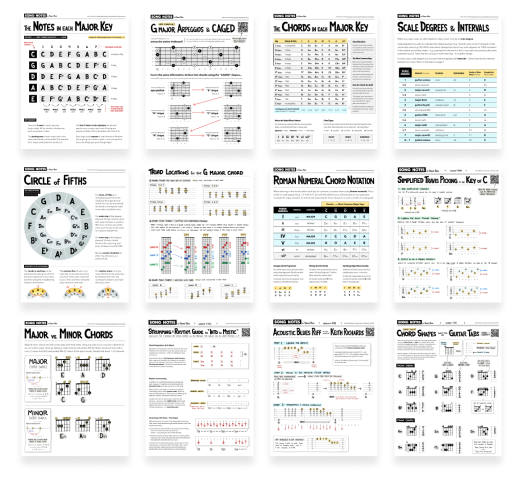Murder ballad groove in A-minor
Lesson #179 • Oct 1, 2018
Video Overview
Instructional PDF 3 pages
Editor’s notes
This exercise is inspired by the bluesy, folksy riffs heard in the Colter Wall murder ballad “Kate McCannon”. Each of the two sequences are based in A-minor, and use a relatively small amount of repeated flourish notes on the 5th and 6th strings. What’s great though, is how these sequences can be dialed up or down in their intensity – which makes for some nice practice opportunity when it comes to dynamics as part of musical storytelling.
Full riff for this exercise
Sequence 1:
E —–—–––0–0–—–––0—0–—–––0–0–—–––0–0––
B —–—–––1–1–—–––1—1–—–––1–1–—–––1–1––
G —–—–––2–2–—–––2—2–—–––2–2–—–––0–0––
D —–—–––2–2–—–––2—2–—–––2–2–—–––2–2–– ...repeat
A —–0–——–—–—–———–—––0——––––—––––—––––
E —–—––––—–—0—–––––––—–––––—0h3––––––
Am
Sequence 2:
E —–—–—–—––0–0––—––––––––0—0––––––––3–3–––––––––––0–0—––
B —–—–—–—––1–1––—––––––––1—1––––––––0–0–––––––––––1–1—––
G —–—–—–—––2–2––—––––––––2—2––––––––0–0–––––––––––2–2—––
D —–—–—–—––2–2––—––––––––2—2––––––––0–0–––––––––––2–2—–– ...repeat
A —–––—–0–—–—–—–3—0—–—0––——–—–––––––2–2—––2–0–––0––—––––
E —–0–3–—–––—–—––—––3–––––—–—–0–2–3––––—––––––3––––—––––
Am G Am
Playing the chords
You’ll need to know these two chords. An important note here is the fingers used in your G-major chord voicing: note how the left ring finger plays the 6th string bass note. This may feel awkward if you’ve never learned it, but is worth becoming familiar with for songs such as this.
E —––0––– E —––3––– <= left pinky
B —––1––– <= left index B —––0–––
G —––2––– <= left ring finger G —––0–––
D —––2––– <= left middle finger D —––0–––
A —––0–—– A —––2–—– <= left middle finger
E —––—––– E —––3––– <= left ring finger
Am G
How to learn sequence #1
Here’s a step-by-step guide to learning the first sequence. In essence, this is just an A-minor chord played by plucking alternating bass notes before each strum.
E —–—–––0–––—–––0—––—–––0–––—–––0––––
B —–—–––1–––—–––1—––—–––1–––—–––1––––
G —–—–––2–––—–––2—––—–––2–––—–––2––––
D —–—–––2–––—–––2—––—–––2–––—–––2––––
A —–0–——–—–—–———–—––0——––––—–––––––––
E —–—––––—–—0—–––––––—–––––—0––––––––
1 + 2 + 3 + 4 + 1 + 2 + 3 + 4 +
Next, we’re going to add a simple 6th string walk-up at the end of the sequence. Use your left ring finger to play this 3rd fret note. Also, note that the very first time you play this, you’ll want to start on the 3 count (*) so the walk-up kicks things off. From there, just repeat the entire sequence over and over.
E —–—–––0–––—–––0—––—–––0–––—–––—––––
B —–—–––1–––—–––1—––—–––1–––—–––—––––
G —–—–––2–––—–––2—––—–––2–––—–––—–––– Start on the 3 count (*), then
D —–—–––2–––—–––2—––—–––2–––—–––—–––– ...repeat the entire sequence
A —–0–——–—–—–———–—––0——––––—––––—––––
E —–—––––—–—0—–––––––—–––––—0–––3––––
*
1 + 2 + 3 + 4 + 1 + 2 + 3 + 4 +
The next step is to add double-strumming to each of the chord strums. That is, a single “down” strum becomes a “down up” within the same amount of time.
E —–—–––0–0–—–––0—0–—–––0–0–—–––—––––
B —–—–––1–1–—–––1—1–—–––1–1–—–––—––––
G —–—–––2–2–—–––2—2–—–––2–2–—–––—–––– Start on the 3 count (*), then
D —–—–––2–2–—–––2—2–—–––2–2–—–––—–––– ...repeat the entire sequence
A —–0–——–—–—–———–—––0——––––—––––—––––
E —–—––––—–—0—–––––––—–––––—0–––3––––
*
1 + 2 + 3 + 4 + 1 + 2 + 3 + 4 +
Finally, we’ll add some complexity to the walk-up by (1) using a hammer-on to go from the open to 3rd fret; and also (2) adding a “down up” strum of the would-be A-minor chord shape - which will have the G string open, since that left-hand finger is playing the 6th string walkup note.
E —–—–––0–0–—–––0—0–—–––0–0–—–––0–0––
B —–—–––1–1–—–––1—1–—–––1–1–—–––1–1––
G —–—–––2–2–—–––2—2–—–––2–2–—–––0–0–– Start on the 3 count (*), then
D —–—–––2–2–—–––2—2–—–––2–2–—–––2–2–– ...repeat the entire sequence
A —–0–——–—–—–———–—––0——––––—––––—––––
E —–—––––—–—0—–––––––—–––––—0h3––––––
*
1 + 2 + 3 + 4 + 1 + 2 + 3 + 4 +
How to learn sequence #2
This sequence is a bit more heavy with the walkups and walkdowns. When starting off your practice, only do a single downstrum on each of the chords you’re playing.
E —–—–—–—––0––––—––––––––0—–––––––––3–––––––––––––0––—––
B —–—–—–—––1––––—––––––––1—–––––––––0–––––––––––––1––—––
G —–—–—–—––2––––—––––––––2—–––––––––0–––––––––––––2––—––
D —–—–—–—––2––––—––––––––2—–––––––––0–––––––––––––2––—––
A —–––—–0–—–—–—–3—0—–—0––——–—–––––––2––—––2–0–––0––—––––
E —–0–3–—–––—–—––—––3–––––—–—–0–2–3––––—––––––3––––—––––
Am G Am
Once you have the above sequence under control, you can spice up the downstrums by turning them into a “down up” instead. This helps fill things out a bit.
E —–—–—–—––0–0––—––––––––0—0––––––––3–3–––––––––––0–0—––
B —–—–—–—––1–1––—––––––––1—1––––––––0–0–––––––––––1–1—––
G —–—–—–—––2–2––—––––––––2—2––––––––0–0–––––––––––2–2—––
D —–—–—–—––2–2––—––––––––2—2––––––––0–0–––––––––––2–2—––
A —–––—–0–—–—–—–3—0—–—0––——–—–––––––2–2—––2–0–––0––—––––
E —–0–3–—–––—–—––—––3–––––—–—–0–2–3––––—––––––3––––—––––
Am G Am
Good luck!
I hope you enjoyed this exercise. I recommend checking out the Colter Wall song “Kate McCannon” to see these two riffs in use - he does a great job capturing raw emotion in that song.
Enjoy My Lessons? Show Your Support!
Most of the lessons on my website are 100% free. If you have the means, please show your support with a tip jar contribution. I put many hours into every lesson — but it only takes you a minute to make a donation. You have my thanks!
Looking for More Song Lessons?
Featured Courses
Fun & Helpful Tools I've Made
Coming soon is Jambox – which shows all the video jam tracks I've made. It's note quite ready for the spotlight, but check it out if you like!
Subscribe to my YouTube channel
Be sure to never miss a lesson by subscribing on YouTube. I put out 2-3 new videos every week. These include full song lessons, as well as covers, practice tips, behind-the-scenes updates. Thanks!
Recent Lessons
-
Dec 19, 2025
"Fairytale of New York" by The Pogues
-
Dec 12, 2025
"The Christmas Song" by Nat King Cole
-
Dec 4, 2025
"If I Needed You" by Emmylou Harris & Don Williams
-
Nov 21, 2025
Learn to Play "Hey Joe", Step-by-Step
-
Nov 15, 2025
Songs Using the One-Four-Five Chords
-
October 31, 2025
"Long Cool Woman (In a Black Dress)" by The Hollies
-
October 24, 2025
"Dust in the Wind" Intro Fingerstyle, Step-by-Step
-
Oct 18, 2025
"America" by Simon & Garfunkel
-
Oct 8, 2025
Rhythm Deep-Dive: "Wild World" by Cat Stevens


